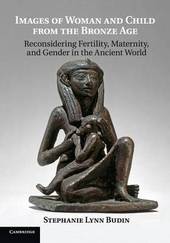
|
Images of Woman and Child from the Bronze Age: Reconsidering Fertility, Maternity, and Gender in the Ancient World
Paperback / softback
Main Details
| Title |
Images of Woman and Child from the Bronze Age: Reconsidering Fertility, Maternity, and Gender in the Ancient World
|
| Authors and Contributors |
By (author) Stephanie Lynn Budin
|
| Physical Properties |
| Format:Paperback / softback | | Pages:396 | | Dimensions(mm): Height 254,Width 178 |
|
| Category/Genre | Pre-history
Prehistoric archaeology |
|---|
| ISBN/Barcode |
9781107660328
|
| Classifications | Dewey:930 |
|---|
| Audience | | Postgraduate, Research & Scholarly | |
|---|
| Illustrations |
30 Halftones, unspecified; 16 Line drawings, unspecified
|
|
Publishing Details |
| Publisher |
Cambridge University Press
|
| Imprint |
Cambridge University Press
|
| Publication Date |
21 April 2014 |
| Publication Country |
United Kingdom
|
Description
This book is a study of the woman-and-child motif - known as the kourotrophos - as it appeared in the Bronze Age eastern Mediterranean. Stephanie Lynn Budin argues that, contrary to many current beliefs, the image was not a universal symbol of maternity or a depiction of a mother goddess. In most of the ancient world, kourotrophic iconography was relatively rare in comparison to other images of women and served a number of different symbolic functions, ranging from honoring the king of Egypt to adding strength to magical spells to depicting scenes of daily life. This work provides an in-depth examination of ancient kourotrophoi and engages with a variety of debates that they have spawned, including their role in the rise of patriarchy and what they say about ancient constructions of gender.
Author Biography
Stephanie Lynn Budin teaches at Rutgers University, Camden. She is the author of The Myth of Sacred Prostitution in Antiquity (Cambridge, 2008) and numerous articles on ancient religion and iconography.
Reviews'The book debunks several long-held and unsubstantiated beliefs in the literature, and reorients our thinking about images of women and children towards a context-specific approach.' Allison Thomason, Near Eastern Archaeology
|